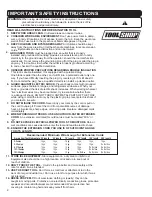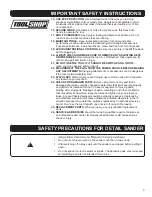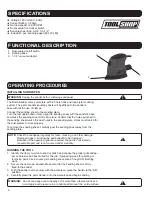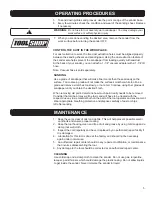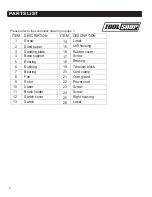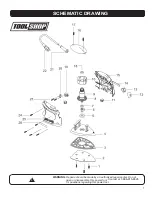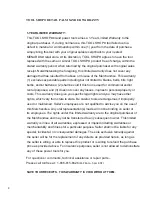
5.
To sand down profiles and grooves, use the point or edge o
f
the sander base.
6.
Every few minutes, check the condition and wear of the sa
n
ding sheet. Replace
if necessary.
5
WARNING:
Do not use torn or severely worn sandpaper. You may damage your
work surface or suffer physical injury.
7.
When you are done sanding the desired area, remove the sander from the
work surface before turning the sander OFF
.
CONTROL THE DUST IN THE WORKPLACE.
For dust collection to work, the five dust extraction holes must be aligned properly
between the sanding sheets and sanding pad. Using the dust extraction feature of
the sander also helps
prevent the sandpaper from loading quickly with sawdust.
At the back of your sande
hose.
Note: Vacuum hose is sold separately.
r
, you can attach a 1-1/4" vacuum adapter with a 1-1/4” ID
SANDING
Use a grade of sandpaper that will make finer marks than those already on the
surface. Too coarse a grade will not make the surface smoother while too fine a
grade will remove s
cratches too slowly
, or not at all. Continue using finer grades of
sandpaper until you obtain the desired finish.
When removing old paint, determine how much paint really needs to be removed.
Consider that old paint may well be toxic and will have to be treated with the
respect due any toxic
material both on the part of the tool operator and environment.
W
ear appropriate breathing protection and dispose carefully of dust or chips
left after sanding.
MAINTENANCE
1.
Keep the vents clear of dust and debris. This will help prevent possible electri
cal shorts and ensure proper cooling.
2.
Keep the tool housing clean and free of oil and grease by using mild soap and a
damp (not wet) cloth.
3.
Inspect the cord regularly and have it replaced by an authorized repair facility if
it is damaged.
4.
Lubrication for this tool is done at the factory and should not be necessary
again under normal use.
5.
An authorized repair center should do any repairs, modification, or maintenance
that involves disassembling the tool.
6.
Any damage to the tool should be corrected at an authorized repair center.
CLEANING
Use mild soap and a damp cloth to clean the sande
r
. Do not use gas, turpentine,
lacquer
, paint thinners which could damage the plastic casing. Do not allow liquids
to get inside the sande
r
. Never immerse the sander in liquid.
OPERATING PROCEDURES
!


